| Revision as of 14:16, 23 January 2019 editHammersfan (talk | contribs)Extended confirmed users43,152 edits →Past fleet← Previous edit | Revision as of 14:17, 23 January 2019 edit undoHammersfan (talk | contribs)Extended confirmed users43,152 editsm →Future fleetNext edit → | ||
| Line 436: | Line 436: | ||
| |} | |} | ||
| ===Future fleet=== | ===Future fleet=== | ||
| IÉ's increasing fleet usage has led to requirements being made for the procurement of additional vehicles. DART services are running with all trains formed of at least six cars, while the entire operational fleet of ICRs is committed to services.<ref name=fleet>{{cite magazine |last=Pritchard |first=Robert |date=February 2019 |title=Current and Future Development on Irish Rail |url= |magazine=Today's Railways |location= |publisher=Platform 5 |access-date= }}</ref> To this end, IÉ plans to purchase a significant number of new ICR vehicles - an initial purchase of 41 will be made for delivery in 2021, comprising three new trains, with the remainder planned as intermediate vehicles to lengthen existing units. The deal for the new vehicles is intended to include options for up to 40 further vehicles.<ref name=fleet /> There are also plans for a total replacement of the existing DART fleet, which will be combined with extensions to the DART network. The framework for the DART fleet is planned for up to 600 vehicles formed into four-car and eight-car sets, split into both pure EMU and ] trains.<ref name=fleet /> For immediate fleet capacity increases, IÉ planned a refurbishment of its 2700 Class DMUs, which was subsequently cancelled. Instead, IÉ is discussing the possibility of sourcing surplus DMUs from the ], with {{BRC|170}}s and {{BRC|185}}s available.<ref name=fleet /> | IÉ's increasing fleet usage has led to requirements being made for the procurement of additional vehicles. DART services are running with all trains formed of at least six cars, while the entire operational fleet of ICRs is committed to services.<ref name=fleet>{{cite magazine |last=Pritchard |first=Robert |date=February 2019 |title=Current and Future Fleet Development on Irish Rail |url= |magazine=Today's Railways |location= |publisher=Platform 5 |access-date= }}</ref> To this end, IÉ plans to purchase a significant number of new ICR vehicles - an initial purchase of 41 will be made for delivery in 2021, comprising three new trains, with the remainder planned as intermediate vehicles to lengthen existing units. The deal for the new vehicles is intended to include options for up to 40 further vehicles.<ref name=fleet /> There are also plans for a total replacement of the existing DART fleet, which will be combined with extensions to the DART network. The framework for the DART fleet is planned for up to 600 vehicles formed into four-car and eight-car sets, split into both pure EMU and ] trains.<ref name=fleet /> For immediate fleet capacity increases, IÉ planned a refurbishment of its 2700 Class DMUs, which was subsequently cancelled. Instead, IÉ is discussing the possibility of sourcing surplus DMUs from the ], with {{BRC|170}}s and {{BRC|185}}s available.<ref name=fleet /> | ||
| == See also == | == See also == | ||
Revision as of 14:17, 23 January 2019
See also: Rail transport in Ireland
| File:Irish rail logo.gif | |
 | |
| Company type | |
|---|---|
| Industry | Rail transport |
| Predecessor | CIÉ Railways Division (1945–1987) |
| Founded | 2 February 1987 |
| Headquarters | Connolly Station, Dublin 1, D01 V6V6, Ireland |
| Area served | Ireland |
| Key people | Jim Meade (Chief Executive) Frank Allen (Chairman) |
| Revenue | |
| Operating income | |
| Net income | |
| Owner | Government of Ireland (100%) |
| Number of employees | 3,803 (2017) |
| Parent | Córas Iompair Éireann |
| Website | www.irishrail.ie |



Iarnród Éireann (Irish pronunciation: [ˈiəɾˠnˠɾˠoːdˠ ˈeːɾʲən̪ˠ]), also known as Irish Rail in English, is the operator of the national railway network of Ireland. Established on 2 February 1987, it is a subsidiary of Córas Iompair Éireann (CIÉ). It operates all internal InterCity, Commuter, DART and freight railway services in the Republic of Ireland, and, jointly with Northern Ireland Railways, the Enterprise service between Dublin and Belfast. In 2018, IÉ carried 48 million passengers, up from 45.5 million in 2017.
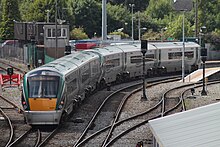
Until 2013 Ireland was the only European Union state that had not implemented EU Directive 91/440 and related legislation, having derogated its obligation to split train operations and infrastructure businesses, and allow open access by private companies to the rail network. A consultation on the restructuring of Iarnród Éireann took place in 2012. The derogation ended on 14 March 2013 when the company was split in 2 sectors: Railway Undertaking and Infrastructure Manager.
Organisation
At the time of its establishment the company referred to itself as Irish Rail, and adopted the four rails IR logo. In 1994, the company brought the Irish form of its name to the fore, introducing a logo and corporate branding based on the letters IÉ (Iarnród_Éireann) corporate branding and logo. However, both languages remained part of the official company name ("Iarnród Éireann – Irish Rail"). In 2013, new bilingual branding was introduced.
Operationally, services are divided across four regional areas:
- Northern and Eastern services are managed from Connolly (including Sligo in the North-West)
- Southern and Western services are managed from Heuston
Services
Passenger services
IÉ's passenger services are branded under three main names; InterCity, Commuter and DART.
InterCity

InterCity services are long-distance routes radiating mainly from Dublin. The Belfast – Dublin service, jointly operated with Northern Ireland Railways, is branded separately as Enterprise. Dublin's two main InterCity stations are Connolly and Heuston. Intercity services run to/from Cork, Limerick, Tralee, Ennis, Galway, Waterford, Rosslare Europort, Sligo, Westport, Wexford and Ballina. Dublin's third major station, Pearse, is the terminus for much of the suburban network in the Greater Dublin area. An additional InterCity service runs from Limerick to Waterford although this is currently operated by Commuter railcars. This service formerly operated through to Rosslare Europort but services between Waterford and Rosslare Europort ceased after the last train on 18 September 2010. Bus Éireann now operates route 370 through the affected towns as replacement transport.
A new service began on 31 March 2010 from Limerick to Galway, as part of the Western Rail Corridor, a reopening of a long-closed line.
A January 2012 national newspaper article suggested that Iarnród Éireann was expected to seek permission in the near future from the National Transport Authority to close the Limerick–Ballybrophy railway line.
Commuter
Main article: Commuter (Iarnród Éireann)
The majority of Commuter services are based in Dublin, which has four commuter routes: Northern (Dundalk), Western (Maynooth/Longford), South Western (Newbridge/Kildare/Portlaoise) and South Eastern (Gorey). See Dublin Suburban Rail for more details. The Cork Suburban Rail currently has three Commuter services: to Mallow and Cobh, and a third service to Midleton which became operational on a part of the disused Youghal branch line on 30 July 2009. Limerick Suburban Rail currently consists of two lines to Ennis and Nenagh, with shuttle services to Limerick Junction. A Commuter service operates between Galway to Oranmore and Athenry.
Commuter trains also operate on shuttle duty for branches from the main InterCity services from Mallow to Tralee (off the Dublin – Cork route) and from Manulla Junction to Ballina (off the Dublin – Westport route), as well as acting as InterCity trains for Dublin – Rosslare and some Dublin – Sligo services, and as the aforementioned Limerick – Limerick Junction – Waterford service.
DART


The North-South route along Dublin's eastern coastal side is also host to DART, Ireland's only electrified heavy-rail service. The DART consists of many classes, the most famous one being the 8100 class which still operate, now extensively refurbished.
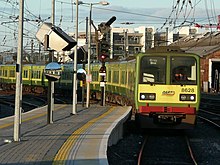
Freight services
Iarnród Éireann also has responsibility for running freight services on the Irish network through its Freight Division – which recorded a tonnage decrease of 1% in 2017, and as of 2018 there are 2 freight flows running throughout the country. This operates both Railfreight trains, and a network of road haulage through various distribution nodes throughout the country. Iarnród Éireann Freight is subdivided into three sections:
- Bulk Freight – specialises in operating full train loads of freight, usually bulk movements of single products such as cement, mineral ore or timber.
- Intermodal – container trains, currently operated between Waterford Port and Ballina and Dublin Port and Ballina.
- Navigator – the freight forwarding division, particularly associated with the transport of automotive stock parts.
Operational details
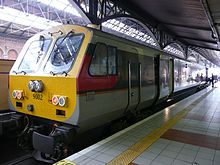
The Enterprise route (Dublin to Belfast) is well regarded. However it is only double track and serves both local and intermediate Commuter as well as InterCity traffic. Hence any delay has knock on effects. Also there is limited platform availability at Connolly Station in Dublin. There was also a persistent problem with engine overloading, as Enterprise locomotives also supplied coach power. However, since September 2012, additional power is provided by separate Mark 3 generator vans.
The Cork-Dublin route was formerly the "premier line" of the Great Southern and Western Railway, one of the biggest pre-CIÉ operators. Rolling stock on this route consists of Mark 4 trains, which were built in Spain, complete with DVTs for faster turn-around. 22000 Class DMUs built in South Korea came into service from early 2007 replacing older coaching stock on most other InterCity routes. These 183 carriages are described by the company as the "Greenest diesel trains in Europe".
The former Minister for Transport, Noel Dempsey TD had announced that an additional 51 railcars had been ordered for the company for a planned introduction on services between Dublin, Louth and Meath. They were placed into service in 2011/2012 but this plan was badly affected by the recession with 21 surplus to requirements at the end of 2012.
The maximum speed of InterCity trains on the IÉ rail network is 160 km/h (100 mph).

Since 2019, Irish Rail have been trying to get more female drivers.
Station names
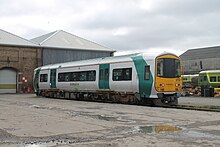
Although the majority of Iarnród Éireann's stations are simply named after the towns they serve, a number of stations in major towns and cities were renamed after leaders of the 1916 Easter Rising, on its 50th Anniversary in 1966:
- Dublin Connolly (formerly Amiens Street)
- Dublin Heuston (formerly Kingsbridge)
- Dublin Pearse (formerly Westland Row)
- Dún Laoghaire Mallin
- Bray Daly
- Cork Kent (formerly Glanmire Road)
- Kilkenny MacDonagh
- Limerick Colbert
- Tralee Casement
- Dundalk Clarke
- Drogheda MacBride
- Sligo Mac Diarmada
- Galway Ceannt
- Waterford Plunkett
- Wexford O'Hanrahan
Network Catering
IÉ's Network Catering unit provided a trolley service of food and drink, a snack car and (on some routes) a restaurant service. It also operated a restaurant at Dún Laoghaire. According to Iarnród Éireann's annual report, the unit lost €270,000 in 2004. Early in 2006, Iarnród Éireann advertised for private catering contractors to take over the operation of its catering services. The service was taken over by Rail Gourmet in March 2007. Rail Gourmet later withdrew from the contract and no longer provide catering for any Irish Rail services.

Rolling stock used by Iarnród Éireann
The Company has a fleet size consisting of 547 carriages (excluding the Enterprise service):
- InterCity services have a fleet of 265 carriages.
- Commuter services have a fleet of 148 carriages.
- DART services have a fleet of 134 carriages.
- Dublin-Belfast Enterprise has a fleet of 28 carriages.
InterCity and Enterprise fleet
- IE 201 Class Locomotive
- IE 22000 Class DMU
- Mark 4
- De Dietrich Rolling stock
Freight service fleet
Current
- CIE 071 Class locomotive
- IE 201 Class locomotive
Former
- CIE 001 Class locomotive
- CIE 121 Class locomotive
- CIE 181 Class locomotive
- CIE 141 Class locomotive
Commuter fleet
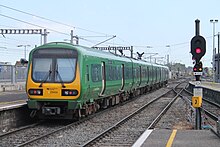
Current
- IE 2600 Class DMU
- IE 2800 Class DMU
- IE 29000 Class DMU
- IE 22000 Class DMU
Former
- IE 2700 Class DMU
- IE 2750 Class DMU
DART fleet

Current
- CIÉ 8100 Class (IE 8300 Class) EMU
- IE 8500 Class EMU
- IE 8510 Class EMU
- IE 8520 Class EMU
Former
- IE 8200 Class EMU
List of Rolling Stock
Current fleet
| Class | Image | Type | Top speed | Number | Routes operated | Introduced | |
|---|---|---|---|---|---|---|---|
| mph | km/h | ||||||
| 071 Class | 
|
Diesel locomotive | 90 | 145 | 18 | Dublin-Navan freight services | 1976 |
| 8100 Class (8300 Class) | 
|
Electrical Multiple Unit | 62 | 100 | 38 (formerly 40) | Howth-Bray, Malahide-Greystones (DART Routes) | 1984 |
| Mark 3 | 
|
Generator van | 100 | 160 | 4 | Dublin-Belfast (Enterprise) | 1980 (Refurbished 2009) |
| 2600 Class | 
|
Diesel Multiple Unit | 70 | 110 | 16 (formerly 17) | Cork Commuter Routes | 1994 |
| 201 Class | 
|
Diesel locomotive | 100 | 160 | 32 | Dublin-Cork, Dublin-Belfast (Enterprise) | 1994-1995 |
| De Dietrich stock | 
|
Passenger coaches | 90 | 145 | 28 | Dublin-Belfast (Enterprise) | 1996 |
| 2800 Class | 
|
Diesel Multiple Unit | 75 | 120 | 8 | Cork & Limerick Commuter Routes | 2000 |
| 8500 Class | 
|
Electrical Multiple Unit | 70 | 110 | 4 | Howth-Bray, Malahide-Greystones (DART Routes) | 2001 |
| 8510 Class | 
|
Electrical Multiple Unit | 70 | 110 | 3 | Howth-Bray, Malahide-Greystones (DART Routes) | 2002 |
| 29000 Class | 
|
Diesel Multiple Unit | 75 | 120 | 29 | Dublin-Rosslare, Dublin Commuter | 2003-2005 |
| 8520 Class | 
|
Electrical Multiple Unit | 70 | 110 | 10 | Howth-Bray, Malahide-Greystones (DART Routes) | 2004 |
| Mark 4 | 
|
Passenger coaches | 125 | 200 | 67 | Dublin-Cork | 2006 |

|
Driving Van Trailer (DVT) | ||||||
| 22000 Class | 
|
Diesel Multiple Unit | 100 | 160 | 28 3-car, 25 4-car & 10 5-car sets | Cork-Tralee, Dublin-Cork, Galway, Limerick, Rosslare, Sligo, Waterford, Westport | 2007-2011 |
Past fleet
| Class | Image | Type | Top speed | Routes operated | Introduced | Number | Withdrawn | Notes | |
|---|---|---|---|---|---|---|---|---|---|
| mph | km/h | ||||||||
| AEC Class | 
|
Diesel Multiple Unit | 62 | 100 | Bray-Greystones (Shuttle services) | 1952-1957 (as railcars) 1972–1975 (as push–pull stock) |
3 | 1987 | 10 Inherited from the UTA. |
| NIR Class 80 | 
|
Diesel Multiple Unit | 70 | 113 | Bray-Greystones (Shuttle services) | 1987 | 3 | 1990 | Passenger DEMU affectionately nicknamed 'Thumpers'.
On loan from NI Railways. |
| 001 Class | 
|
Diesel locomotive | 75 | 120 | Dublin-Navan freight services Dublin-Belfast (Enterprise) |
1955-56 | 10 | 1987-1995 | Intended for loco hauled Enterprise services. |
| 121 Class | 
|
Diesel locomotive | 77 | 124 | Dublin-Galway Dublin-Sligo Dublin-Waterford Suburban routes |
1960-1961 | 14 | 1995-2008 | |
| Mark 2 | 
|
Passenger coaches | 100 | 161 | All routes | 1989 | 15 | 2004-2008 | ex-British Rail Mark 2 |
| 8200 Class | 
|
Electrical Multiple Unit | 68 | 110 | Howth-Bray Malahide-Greystones (DART Routes) |
2000 | 5 | 2007-2008 | All stored at Inchicore. |
| 181 Class | 
|
Diesel locomotive | 75 | 120 | All routes | 1966 | 12 | 1991-2009 | |
| 141 Class | 
|
Diesel locomotive | 76 | 123 | All routes | 1962 | 37 | 2010-2011 | 5 stored at Inchicore |
| 2700 Class | 
|
Diesel Multiple Unit | 68 | 110 | Commuter routes | 1998 | 12 | 2012 | 2716 operated as a hybrid 2-car unit with 2609 (Also withdrawn).
All stored at Inchicore. |
| 2750 Class | 
|
Diesel Multiple Unit | 68 | 110 | Commuter routes | 1998 | 2 | 2012 | |
Future fleet
IÉ's increasing fleet usage has led to requirements being made for the procurement of additional vehicles. DART services are running with all trains formed of at least six cars, while the entire operational fleet of ICRs is committed to services. To this end, IÉ plans to purchase a significant number of new ICR vehicles - an initial purchase of 41 will be made for delivery in 2021, comprising three new trains, with the remainder planned as intermediate vehicles to lengthen existing units. The deal for the new vehicles is intended to include options for up to 40 further vehicles. There are also plans for a total replacement of the existing DART fleet, which will be combined with extensions to the DART network. The framework for the DART fleet is planned for up to 600 vehicles formed into four-car and eight-car sets, split into both pure EMU and BEMU trains. For immediate fleet capacity increases, IÉ planned a refurbishment of its 2700 Class DMUs, which was subsequently cancelled. Instead, IÉ is discussing the possibility of sourcing surplus DMUs from the British network, with Class 170s and Class 185s available.
See also
- List of Irish companies
- List of railway stations in Ireland
- History of rail transport in Ireland
- Transport in Ireland
- Diesel Locomotives of Ireland
- Multiple Units of Ireland
- Coaching Stock of Ireland
References
- ^ Iarnród Éireann. "Iarnród Éireann Annual Report 2017" (PDF). Retrieved 4 October 2018.
- Iarnród Éireann Annual Report 2017
- Sources:
- "Irish government looks at rail restructuring as derogation ends", www.railwaygazette.com, Railway Gazette International, 14 March 2012
- "Changes to Irish Rail on way as Ireland gives up EU exemption", www.thejournal.ie, 14 March 2012
- ^ http://www.independent.ie/irish-news/irish-rail-defends-new-logo-cost-29105397.html
- "Archived copy" (PDF). Archived from the original (PDF) on 20 December 2011. Retrieved 23 April 2011.
{{cite web}}: Unknown parameter|deadurl=ignored (|url-status=suggested) (help)CS1 maint: archived copy as title (link) - http://www.examiner.ie/ireland/iarnrod-eireann-may-close-rail-service-amid-falling-demand-178779.html
- http://www.irishrail.ie/about-us/fleet-investment
- http://www.cie.ie/company-profile-(2)/heritage
- Iarnród Éireann Annual Report 2004
- http://www.railgourmet.com/page2/11/our-companies/
- http://www.irishrail.ie/about-us/intercity-1 Iarnród Éireann InterCity Fleet details
- http://www.irishrail.ie/about-us/commuter Iarnród Éireann Commuter Fleet details
- http://www.irishrail.ie/about-us/dart DART Fleet details
- ^ Pritchard, Robert (February 2019). "Current and Future Fleet Development on Irish Rail". Today's Railways. Platform 5.
External links
- Irish Rail Official Site – Timetables, bookings, operations and corporate site
- Dublin train map
- Irish Railway Record Society
- Eiretrains – Irish Railways Past & Present
| CIÉ | |
|---|---|
| Current rail operators in Ireland | |
|---|---|
| Current Operators | |
| Services | |
| Operated jointly by Iarnród Éireann and Northern Ireland Railways | |
| Transport in Dublin | |||||||||||||||||
|---|---|---|---|---|---|---|---|---|---|---|---|---|---|---|---|---|---|
| Air |
| ||||||||||||||||
| Cycling |
| ||||||||||||||||
| Rail |
| ||||||||||||||||
| Road |
| ||||||||||||||||
| Water |
| ||||||||||||||||
| Agencies | |||||||||||||||||
| *=Tram systems no longer run. Information in parentheses shows the operator(s) | |||||||||||||||||
| National railway companies of Europe | |
|---|---|
| |
|